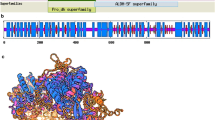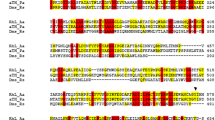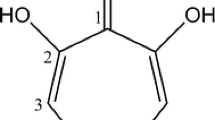Abstract
Treponema denticola convertedl-ornithine, a product ofl-arginine catabolism, to putrescine via a decarboxylation reaction and to proline via a deamination reaction. Ornithine decarboxylation byT. denticola extracts was stimulated by pyridoxal 5′-phosphate. In the absence of pyridoxal 5′-phosphate, (NH4)2SO4-fractionated extracts converted ornithine to proline and ammonia. This activity was not stimulated by α-keto acids, nicotinamide adenine dinucleotide, reduced nicotinamide adenine dinucleotide or ADP. Neither ornithine δ-transaminase (l-ornithine: 2-oxoacid aminotransferase, EC 2.6.1.13) nor Δ1 reductase [l-proline: NAD(P) 5-oxidoreductase, EC 1.5.1.2.] activity was detectable in cell extracts. These results indicate that formation of proline from ornithine inT. denticola is catalyzed by an enzyme system analogous to the ornithine cyclase (deaminating) ofClostridium sporogenes. Exogenous ornithine inhibited the growth ofT. denticola. Thus, in addition to generating putrescine and proline, the ornithine dissimilatory pathways may serve to prevent accumulation of inhibitory concentrations of ornithine in the spirochete's environment.
Similar content being viewed by others
Literature Cited
Applebaum, D. M., Dunlap, J. C., Morris, D. R. 1977. Comparison of the biosynthetic and biodegradative ornithine decarboxylases ofEscherichia coli. Biochemistry16:1580–1584.
Applebaum, D., Sabo, D. L., Fischer, E. H., Morris, D. R. 1975. Biodegradative ornithine decarboxylase ofEscherichia coli. Purification, properties and pyridoxal 5′-phosphate binding site. Biochemistry14:3675–3681.
Bacchi, C. J., Lipschik, G. Y., Nathan, H. C. 1977. Polyamines in trypanosomatids Journal of Bacteriology131:657–661.
Blakemore, R. P., Canale-Parola, E. 1976. Arginine catabolism byTreponema denticola. Journal of Bacteriology128:616–622.
Chinard, F. P. 1952. Photometric estimation of proline and ornithine. Journal of Biological Chemistry199:91–95.
Costilow, R. N., Laycock, L. 1968. Proline as an intermediate in the reductive deamination of ornithine to δ-aminovaleric acid. Journal of Bacteriology96:1011–1020.
Costilow, R. N., Laycock, L. 1969. Reactions involved in the conversion of ornithine to proline in clostridia. Journal of Bacteriology100:662–667.
Costilow, R. N., Laycock, L. 1971. Ornithine cyclase (deaminating). Purification of a protein that converts ornithine to proline and definition of the optimal assay conditions. Journal of Biological Chemistry246:6655–6660.
Cwyk, W. M., Canale-Parola, E. 1979.Treponema succinifaciens sp. nov., an anaerobic spirochete from the swine intestine. Archives of Microbiology122:231–239.
Gale, E. F. 1946. The bacterial amino acid decarboxylases, pp. 1–32. In: Nord, F. F. (ed.), Advances in enzymology, vol. 6, New York: Interscience.
Gerritsen, T., Rehberg, M. L., Waisman, H. A. 1965. On the determination of free amino acids in serum. Analytical Biochemistry11:460–466.
Gochman, N., Meyer, R. K., Blackwell, R. Q., Fosdick, L. S. 1959. The amino acid decarboxylases of salivary sediment. Journal of Dental Research38:998–1003.
Grettie, D. P., Bartos, D., Bartos, F., Smith, R. G., Campbell, R. A. 1978. Purification of radiolabeled polyamines and isolation of polyamines from serum by silica gel chromatography, pp. 13–21. In: Campbell, R. A., Morris, D. R., Bartos, D., Daves, G. D., Bartos, F. (eds.) Advances in polyamine research, vol. 2. New York: Raven Press.
Hammond, J. E., Herbst, E. J. 1968. Analysis of polyamines by thin-layer chromatography. Analytical Biochemistry22:474–484.
Hespell, R. B., Canale-Parola, E. 1971. Amino acid and glucose fermentation byTreponema denticola. Archiv für Mikrobiologie78:234–251.
Hyatt, A. T., Hayes, M. L. 1975. Free amino acids and amines in human dental plaque. Archives of Oral Biology20:203–209.
Jenkins, W. T., Tsai, H. 1970. Ornithine aminotransferase (pig kidney), pp. 281–285. In: Tabor, H., Tabor, C. W. (eds.), Methods in enzymology, vol. XVIIA. New York: Academic Press.
Kleinberg, I. 1970. Regulation of the acid-base metabolism of the dentogingival plaque and its relation to dental caries and periodontal disease. International Dental Journal20:451–465.
Meister, A. 1965. Biochemistry of the amino acids, 2nd ed. New York, London: Academic Press.
Middelhoven, W. J. 1964. The pathway of arginine break-down inSaccharomyces cerevisiae. Biochimica et Biophysica Acta93:650–652.
Muth, W. L., Costilow, R. N. 1974. Ornithine cyclase (deaminating). II. Properties of the homogeneous enzyme. Journal of Biological Chemistry249:7457–7462.
Raina, A. 1963. Studies on the determination of spermidine and spermine and their metabolism in the developing chick embryo. Acta Physiologica Scandinavica 60, Suppl.218:1–81.
Rosen, H. 1957. A modified ninhydrin colorimetric analysis for amino acids. Archives of Biochemistry and Biophysics67:10–15.
Scher, W. I. Jr., Vogel, H. J. 1957. Occurrence of ornithine δ-transaminase: A dichotomy. Proceedings of the National Academy of Sciences of the United States of America43:796–803.
Spackman, D. H., Stein, W. H., Moore, S. 1958. Automatic recording apparatus for use in the chromatography of amino acids. Analytical Chemistry30:1190–1206.
Stanton, T. B., Canale-Parola, E. 1979. Enumeration and selective isolation of rumen spirochetes. Applied and Environmental Microbiology38:965–973.
Tabor, C. W., Tabor, H. 1976. 1,4-Diaminobutane (putrescine), spermidine and spermine. Annual Review of Biochemistry45:285–306.
Umbreit, W. W., Burris, R. H., Stauffer, J. F. 1964. Manometric techniques, 4th ed. Minneapolis: Burgess.
Wolfe, R. S. 1971. Microbial formation of methane, pp. 107–146. In: Rose, A. H., Wilkinson, J. F. (eds.), Advances in microbial physiology, vol. 6, New York: Academic Press.
Author information
Authors and Affiliations
Rights and permissions
About this article
Cite this article
Leschine, S.B., Canale-Parola, E. Ornithine dissimilation byTreponema denticola . Current Microbiology 3, 305–310 (1980). https://doi.org/10.1007/BF02601811
Issue Date:
DOI: https://doi.org/10.1007/BF02601811




